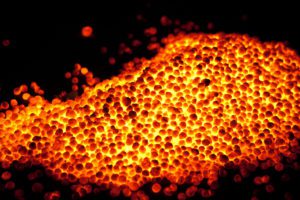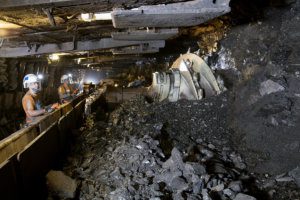
Ferrexpo Plc (the U.K.), controlling Poltava and Yeristovo mining combines, in 2018 increased total pellet production by 1.6% compared with 2017, to 10.607 million tonnes.
According to a press release of the company issued on Tuesday, over the period production of 65% Fe pellets (Ferrexpo Premium Pellets, FPP and Ferrexpo Premium Pellets plus, FPP+) totaled 9.95 million tonnes (a rise of 0.4%) and 62% Fe pellets (Ferrexpo Basic Pellets, FBP) – 682,490 tonnes (a rise of 22.2%).
Production of 65% Fe pellets from own ore was 9.824 million tonnes (a fall of 0.1%) and 62% Fe pellets – 682,490 tonnes (a rise by 22.2%).
In Q4 2018, total pellet production grew by 7.2% compared with Q3 2018, to 2.851 million tonnes.
“Total 2019 pellet production is expected to be in line with 2018 at 10.6 million tonnes as a result of ongoing maintenance,” the company said.
2018 sales volumes will be approximately 10.2 million tonnes (2017 sales volumes: 10.5 million tonnes). Sales volumes were impacted by reduced barge shipments given the low water levels on the Danube River in H2 2018. Slower than expected rail shipments in December 2018 and the timing of a capesize shipment falling into January 2019 also impacted sales volumes. The group expects these sales volumes to be caught up in H1 2019.
The group’s average received price was approximately 9% higher in 2018 compared to 2017, reflecting stronger premiums for higher quality iron ore, including higher average pellet premiums, offset by a slightly lower average 62% Fe iron ore fines price and higher international freight rates.
“The full year average 2018 cash cost of production is expected to be approximately $44 per tonne compared to $33 per tonne in 2017 due to higher energy prices and increased mining costs. Net debt as of December 31, 2018 was approximately $340 million (December 31, 2017: $403 million). The group’s cash balance as of December 31, 2018 was approximately $60 million while undrawn available debt facilities amounted to $205 million, the press service said.

The Cabinet of Ministers of Ukraine has approved a bill reducing the preferential imports duty on yarn (other than sewing thread) of synthetic staple fibers used for production of sewing thread from 4% to nil.
The bill amending the Customs Tariff of Ukraine was approved at a government meeting on Thursday.
According to the bill, the law will take effect in 45 days from the moment of its publication.
Nil rates are set for multiple (folded) or cabled yarn (Ukrainian Commodity Code 5509 22 00 00, as well as mixed mainly or solely with cotton yarn (5509 53 00 00). At present the preferential rate is 4% and the full rate is 15%.
According to the explanatory note to the document, the bill was designed pursuant to an order from the Cabinet of Ministers on the results of a meeting between the Prime Minister and the heads of light industry enterprises in Bohuslav in January 2018.
Today the work of light industry enterprises is more than 90% dependent on imports of raw materials, including cotton fiber, chemical fibers and threads, wool, yarn, fabrics, dyes that are not produced in Ukraine or are limited.
Over the past three years, imports of sewing threads only from synthetic staple fibers made of yarn mentioned in the draft and widely used by the population and more than 1,500 domestic enterprises producing clothing reached more than 1,100 tonnes worth $8.1. million, according to the document.
At the same time, more than 80% of volumes are imported from China (60%) and Turkey (20%) with a zero rate of duty.
At the same time, at the end of 2017, a new domestic facility producing sewing threads under the Barva trademark (the group of companies Textile-Contact) was created in Ukraine, and the raw materials for their production are subject to a 4% import duty.
The main suppliers of this yarn are China, India, and Indonesia.

Coal mining enterprises of Ukraine in January-October 2018 reduced extraction of coal by 4.1% (by 1.189 million tonnes) compared to the same period in 2017, to 27.688 million tonnes.
The Ministry of Energy and Coal Industry told Interfax-Ukraine production of coking coal decreased by 11.7% (by 652,500 tonnes), to 4.908 million tonnes, steam coal by 2.3% % (536,800 tonnes), to 22.779 million tonnes.
In October 2018, production of run-of-mine (ROM) coal grew by 5% compared to the same month in 2017, to 2.839 million tonnes.
Coal mining companies managed by the ministry for the ten months ending October 2018 reduced production by 13.3%, to 3.454 million tonnes, in particular production of coking coal was down by 42.8%, to 436,000 tonnes, steam coal decreased by 6.3%, to 3.018 million tonnes.
The mines of Donetsk region for the ten months of this year provided production of 9.253 million tonnes of coal (2.6% less compared to January-October 2017), Luhansk region some 427,300 tonnes (down by 73.3%), Dnipropetrovsk region some 16.594 million tonnes (1.1% more), Lviv region some 1.324 million tonnes (3.8% up), and Volyn region some 89,400 tonnes (1.9% up).

PJSC Ukrnafta in January-November 2018 increased production of oil and gas condensate by 5.1% or 65,000 tonnes year-over-year, to 1.324 million tonnes, the company’s press service has reported.
Over the period average daily oil production was 4,000 tonnes (5.1% more than a year ago).
The company recalled that positive dynamics was observed thanks to the resumption of operation at wells at six fields, which Ukrnafta was forced to stop in the second half of 2017, as well as thanks to measures aimed at intensifying production at the existing well stock.
According to the company, gas production in January-November 2018 decreased by 3.1% (by 32 million cubic meters), to 986 million cubic meters, and the production of liquefied gas – by 5.7% (6,000 tonnes), to 100,000 tonnes.
In general, in January-November 2018, Ukrnafta carried out 14 hydraulic fractures, completed the overhaul of 97 wells, and carried out 80 operations to intensify production.
“Thanks to the overhaul, as of the end of November, an additional 51,600 tonnes of oil and condensate were produced, as well as 68.1 million cubic meters of gas. Intensification of operations added 24,100 tonnes of oil and 7.1 million cubic meters of gas,” the company said.
Ukrnafta predicts to increase in annual oil and condensate production by 5% by the end of 2018 compared to the planned figure (1.38 million tonnes), to 1.45 million tonnes. Gas production could grow by 11%, to 1.08 billion cubic meters (the target is 0.97 billion cubic meters, production in 2017 amounted to 1.11 billion cubic meters).
Ukrnafta is the largest oil producing company in the country.
Naftogaz Ukrainy owns 50% plus one share in Ukrnafta and companies associated with the former shareholders in PrivatBank own about 42%.

The production of milk in Ukraine in January-November 2018 declined by 1.9% compared to the same period in 2017, to 9.457 million tonnes. At the same time, egg production in January-November grew by 3.3% compared to the same period in 2017, to 14.982 billion eggs, the State Statistics Service of Ukraine said.
Production of meat (in live weight) in January-November 2018 grew by 0.8%, to 2.88 million tonnes.
According to earlier statistics reports, milk production in Ukraine in 2017 decreased by 0.5% from 2016, to 10.329 million tonnes, meat (in live weight) by 0.4%, to 3.259 million tonnes. Production of eggs in 2017 rose by 3.2%, to 15.578 billion eggs.
EGGS, MEAT, MILK, PRODUCTION

PJSC Farmak pharmaceutical company (Kyiv) has opened a new section of tablet production, investment in which amounted to EUR 20 million. Head of the supervisory board of the company Filia Zhebrovska said at the ceremony of opening the site in Kyiv that this project will allow Farmak to double the capacity of production of solid dosage forms to 3 billion tablets per year.
In general, it is planned in 2019 to transfer and master production of about 30 goods at new site TLF-2, including the drugs from the Available Medicines reimbursement program. Zhebrovska noted that the latest technology of pharmaceutical production and the most modern equipment are used on the site. The project has been implemented during two years. Due to the increase in capacity, Farmak will create almost 100 new jobs. “Our state needs investments for economic growth, contributing to the development of production and strengthening Ukraine’s position in the international arena,” she said.
Equipment from the leading European brands Glatt, IMA, Marchesini and others has been installed at Farmak’s new production site, which provides the entire technological cycle of tablet production from accepting and processing raw materials to the final dosage forms.
The opening of the production site brings PJSC Farmak closer to the strategic goal: the increase in exports to 40% by 2023.